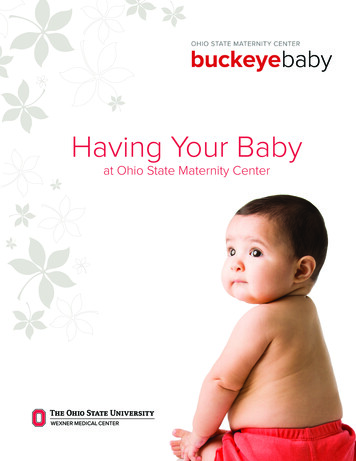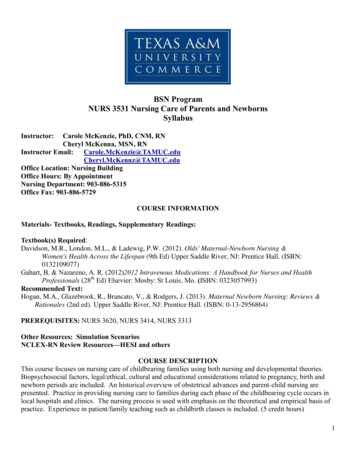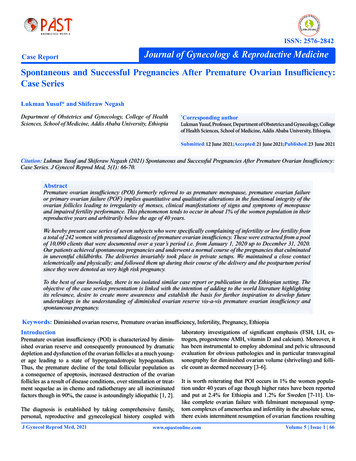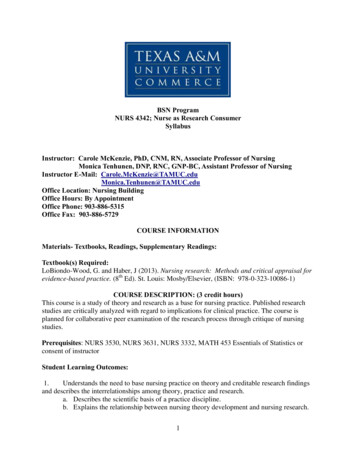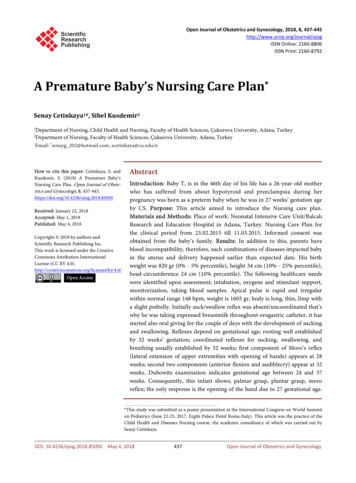
Transcription
Open Journal of Obstetrics and Gynecology, 2018, 8, 437-445http://www.scirp.org/journal/ojogISSN Online: 2160-8806ISSN Print: 2160-8792A Premature Baby’s Nursing Care Plan*Senay Cetinkaya1#, Sibel Kusdemir2Department of Nursing, Child Health and Nursing, Faculty of Health Sciences, Çukurova University, Adana, TurkeyDepartment of Nursing, Faculty of Health Sciences, Çukurova University, Adana, Turkey12How to cite this paper: Cetinkaya, S. andKusdemir, S. (2018) A Premature Baby’sNursing Care Plan. Open Journal of Obstetrics and Gynecology, 8, eived: January 22, 2018Accepted: May 1, 2018Published: May 4, 2018Copyright 2018 by authors andScientific Research Publishing Inc.This work is licensed under the CreativeCommons Attribution InternationalLicense (CC BY en AccessAbstractIntroduction: Baby T, is in the 46th day of his life has a 26-year-old motherwho has suffered from about hypotyroid and preeclampsia during herpregnancy was born as a preterm baby when he was in 27 weeks’ gestation ageby CS. Purpose: This article aimed to introduce the Nursing care plan.Materials and Methods: Place of work: Neonatal Intensive Care Unit/BalcalıResearch and Education Hospital in Adana, Turkey. Nursing Care Plan forthe clinical period from 23.02.2015 till 11.03.2015. Informed consent wasobtained from the baby’s family. Results: In addition to this, parents haveblood incompatibility, therefore, such combinations of diseases impacted babyin the uterus and delivery happened earlier than expected date. His birthweight was 820 gr (0% - 5% percentile), height 34 cm (10% - 25% percentile),head-circumference 24 cm (10% percentile). The following healthcare needswere identified upon assessment; intubation, oxygene and stimulant support,monitorization, taking blood samples. Apical pulse is rapid and irregularwithin normal range 148 bpm, weight is 1605 gr, body is long, thin, limp witha slight potbelly. Initially suck/swallow reflex was absent/uncoordinated that’swhy he was taking expressed breastmilk throughout orogastric catheter, it hasstarted also oral giving for the couple of days with the development of suckingand swallowing. Reflexes depend on gestational age; rooting well establishedby 32 weeks’ gestation; coordinated reflexes for sucking, swallowing, andbreathing usually established by 32 weeks; first component of Moro’s reflex(lateral extension of upper extremities with opening of hands) appears at 28weeks; second two components (anterior flexion and audiblecry) appear at 32weeks. Dubowitz examination indicates gestational age between 24 and 37weeks. Consequently, this infant shows, palmar grasp, plantar grasp, mororeflex; the only response is the opening of the hand due to 27 gestational age.*This study was submitted as a poster presentation at the International Congress on World Summiton Pediatrics (June 22-25, 2017, Ergife Palace Hotel Roma-Italy). This article was the practice of theChild Health and Diseases Nursing course, the academic consultancy of which was carried out bySenay Cetinkaya.DOI: 10.4236/ojog.2018.85050 May 4, 2018437Open Journal of Obstetrics and Gynecology
S. Cetinkaya, S. KusdemirApgar score was 4 - 7 (average, need oxygene and stimulant). Respiration wasshallow, maintain neutral thermal environment, prevent or reduce risk ofpotential irregular, diaphragmatic with intermittent breathing 58/min.Conclusion: Nursing priorities should be promote optimal respiratoryfunctioning, complications, maintain homeostasis, foster development ofhealthy family unit.KeywordsBirth, Newborn, Nursing, Premature1. IntroductionIt is both a developmental and situational crisis in which to: give birth, to join ofa new member into the family and to accept the new participant’s membershipwith the cause of any health problem into the hospital. In such a case, theparents find themselves in a confusion without experiencing the happiness ofhaving a child. The birth of a risky baby is a traumatic event for the family andcauses the family to live crisis [1].The first minutes of the newborn came into the world is very importantbecause it is an indicator of the extrauterine adaptation to life. In order tomaintain the health of the newborn, the importance of an effective care in theearly postpartum period should not be overlooked [1]. The team involved in thebirth should carefully evaluate the first minute of the newborn’s life and examinethe statements indicating that the baby’s condition may be compromised.Assessment of these symptoms and appropriate interventions will affect thewhole life of the baby [1] [2].2. Practise ReportBaby T, is in the 46th day of his life has a 26 year old mother who has sufferedfrom about hypotyroid and pre-eclampsiaduring her pregnancy was born in07.01.2015 as a preterm baby when he was in 27 weeks’gestation age by CS. Inaddition to this, parents have blood incompatibility, therefore, such combinationsof diseases impacted baby in the uterus and delivery happened earlier thanexpected date 01.03.2015. His birth weight was 820 gr (0% - 5% percentile),height 34 cm (10% - 25% percentile), head-circumference 24 cm (10%percentile).The following healthcare needs were identified upon assessment; intubation,oxygene and stimulant support, monitorization, taking blood samples.Neonatal Assessment Data Base1) CirculationApical pulse is rapid and irregular within normal range 148 bpm.2) Food/FluidDOI: 10.4236/ojog.2018.85050438Open Journal of Obstetrics and Gynecology
S. Cetinkaya, S. KusdemirWeight less than 2500 (Birth weight: 820 gr, now: 1605 gr).3) Body long, thin, limp with a slight potbellyInitially suck/swallow reflex was absent/uncoordinated that’s why he wastaking expressed breastmilk throughout orogastric catheter, it has started alsooral giving for the couple of days with the development of sucking andswallowing.4) NeurosensoryHead size large in relation to body; sutures are easily movable; fontanelles areopen 2 1 cm. Edema of eyelids common.Reflexes depend on gestational age;rooting well established by 32 weeks’ gestation; coordinated reflexes for sucking,swallowing, and breathing usually established by 32 wk; first component ofMoro’s reflex (lateral extension of upper extremities with opening of hands)appears at 28 wk; second two components (anterior flexion and audiblecry)appear at 32 wk. Dubowitz examination indicates gestational age between 24 and37 wk. Consequently, I can say that this infant shows, palmar grasp, plantargrasp, moro reflex; the only response is the opening of the hand due to 27gestational age.Infant is responsive to sound and movement. No drooping or paralysis notedin face.5) RespirationApgar score was 4 - 7 (average, need oxygene and stimulant) at birth.Respiration was shallow, irregular, diaphragmatic with intermittent breathing58/min.Grunting, nasal flaring, substernal retractions.6) SafetyTemperature is stabile but still has a risk for hypothermia.7) Cry is weakFace is bruised, baby active, skin slightly translucent with olive undertones,head can be considered normocephalic, milia present across nose, eyes and earslevel, nostrils equal, sclera bluish-white, ears are symmetrical well-formed, nolesions noted, clavicles straight and intact, nipples unclear but symmetric,umblical cord dry, no bleeding, buttocks symmetric, sole and buttocks creasespresent.8) SexualityMale testes descended, rugae absent on scrotum.9) EliminationNot observed elimination problem.3. Diagnostıc StudiesChoice of tests and the expected results depend on presenting problems andsecondary complications1) Serum Electrolytes:-Na: 136 mg/dl it is susceptible to critical fluctiations (The reference range is131 - 145 mmol/L).DOI: 10.4236/ojog.2018.85050439Open Journal of Obstetrics and Gynecology
S. Cetinkaya, S. Kusdemir2) Hematologic tests:-Hb: 15.6 (The reference range is 13.5 - 21.5 g/dL).-Htc: 38.5 (The reference range is 42% - 60%)-Plt: 27,000 (Thrombocytopenia may accompany sepsis). (The reference rangeis 150 - 350 103 µ/L).-Wbc: 9300 (which is usually associated with severe bacterial disease) (Thereference range is 9 - 30 103 µ/L).Urinalysis (on second voided specimen): Detects abnormalities, renal injury.-BUN: 42 (The reference range is 5 - 20 mgr/dl).-Creatinin:0.77 (The reference range is 0.3 - 1 mgr/dl).3) Blood type: Infant: A Rh Mother: 0 Rh Father: ARh ABOincompatibility.4) Blood culture: Identify causative organisms associated with sepsis.5) Urine-Specific Gravity: 1005 (Ranges between 1.006 and 1.013; elevatedwith dehydration) , no bacteria6) Vital valuesTemperature: 37.2 C. Pulse: 148/min. Respiration: 58/min. SYS: 72 DIA:38Mean:51 mmHg. SpO2: 98%.4. Medıcations/Plan1) 12 16 cc feeding per a day (120 cc/kg).2) It will be added 5cc eoprotin per 25 cc expressed breastmilk.3) It will be added 1/4 cc faltomalt per 4 feeding.4) D vit 1 3 drops p.o (10.00 am).5) Biogia 1 5 drops p.o (10.00 am).6) Santofer 1 1 drop p.o (10.00 am).7) Netira for eyes, 3 1 drops (during 3 days) (10:00 18:00 02:00).8) P.S. The medication is adjusted by the physician according to the conditionof the baby.5. Nursing Prioritıes1) Promote optimal respiratory functioning.2) Maintain neutral thermal environment.3) Prevent or reduce risk of potential complications.4) Maintain homeostasis.5) Foster development of healthy family unit.6. Discharge Goals1) Maintaining physiological and behavioral homeostasis with minimalexternal support.2) Weight 4 1/2lb or greater appropriate to age/condition.3) Complications prevented/resolving or independently managed.4) Family identifying and using resources appropriately.DOI: 10.4236/ojog.2018.85050440Open Journal of Obstetrics and Gynecology
S. Cetinkaya, S. Kusdemir5) Family demonstrates ability to manage infant care.6) Plan in place to meet needs after dischargeSee Table 1 for nursing care plan (Table 1).7. DiscussionSystematic physical assessment includes the assessment of newborns, initialassessment (Apgar scoring), assessment of extrauterine transition periods andgestational age assessment. Objective evaluation of the baby’s physical conditionat birth can be done with the Apgar scoring system. Apgar score is evaluated at1th, 5th and 10th minutes. The newborn is assessed in five areas, taking intoaccount heart rate, respiration, muscle tone, response to the stimulus and skintone. The Apgar score is obtained by summing the scores of 0, 1, 2 given in eachfield. If the Apgar value is between 8 - 10; the newborn is alive and strong, anormal maintenance is sufficient. If value is between 4 - 7 means baby needsoxygen and warning. Value is below 4 means indicates severe oxygen deficiencyand the newborn urgently needs resuscitation [3] [4].During extrauterine transition period; determination of some irregularities inheart rate, respiration, motor activity, color, mucus production and intestinalactivity, diagnosis of gestational age and birth weight are important becausethese are closely related to perinatal mortality and morbidity. A physicalassessment with be very attentive and be systematic is necessary in order todetect normal signs and understand the specific signs of danger in the newborn.Physical evaluation includes assessment of vital findings, taking of bodymeasurements, and physical examination of the from head to foot. A detailedassessment is needed to determine the level of adaptation of the newborn to lifeand the risk factors that may affect life [4].The growth and development of the newborn depends on a loving family anda supportive environment. Some newborns may be premature, with a low birthTable 1. Nursing Care Plan for the clinical period from 23.02.2015 till 11.03.2015 of Baby T [5]-[10].(a)NURSING DIAGNOSISMay be related to:Immaturity of respitatuvarcenter, limited musculardevelopment, decreasedenergy/fatiguePossibly evidenced by:periods of apnea, nasalflaring, use of accessorymuscles, cyanosis,tachycardiaRISK FOR INEFFECTIVEBREATHING PATTERNDESIRED OUTCOMESACTIONS/ INTERVENTIONSAssess respiratory rate and breathing pattern. Note presence ofapnea and changes in heart rate, muscle tone, and skin colorassociated with procedures or care. Institute continuousNeonate willMaintain periodic breathing respiratory and cardiac monitoring.pattern (apneic periods last Helps in distinguishing normal cyclic periodic breathing pattern5 - 10 sec, followed by short from true apneic spells, which are particularly common prior to30 weeks gestation as we observe Baby T who is 27 gestationperiods of rapidweeks, is tend to present apnea attacks.ventilation),with mucousmembranes pink, and heart Maintain optimal body temperature because even slight increaseor decrease in environmental temperature can lead to apnea.rate 110 160/respiratoryrate 24 - 60. Provide prompt tactile stimulation (e.g., rub infant’s back) ifapnea occurs. Note presence of cyanosis, bradycardia, orhypotonia. Encourage parental contact.DOI: 10.4236/ojog.2018.85050441EVALUATIONGoal Met: BabyT has notshown anyapnea attacks.Open Journal of Obstetrics and Gynecology
S. Cetinkaya, S. Kusdemir(b)NURSING DIAGNOSISDESIRED OUTCOMESMay be related to:Immature CNS development (temperatureregulation center), an inability to shiver orsweat, limited/inability to flex extremities,and frequent medical/nursing manipulationsand interventionsPossibly Evidenced by:Fluctuation of body temperaturebelow/above normal rangeTachypnea/apnea, generalized cyanosis,bradycardia, lethargy(coldstress)Tachycardia, flushed color,lethargy, apnea (hyperthermia)Baby T’s axilla temperature 37.2 C skinwarm and dry, does not appearuncomfortableRISK FOR ALUATIONAssess temperature frequently.Place infant in warmer, incubator, open bed withradiant warmer, or open crib with appropriateclothingUse heat lamps during procedures. Warm objectscoming in contact with infant’s body, such asNeonate willstethoscopes, linens, and
2Department of Nursing, Faculty of Health Sciences, Çukurova University, Adana, Turkey Abstract Introduction : Baby T, is in the 46th day of his life -yearhas a 26-old mother who has suffered from about hypotyroid and preeclampsia during her pregnancy was born as a preterm baby when he was in 27 weeks’ gestation age by CS. Purpose: This article aimed to introduce the Nursing care plan.
